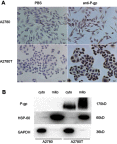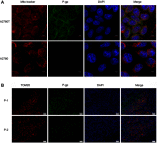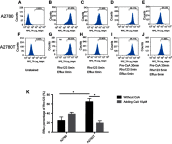Mitochondria P-glycoprotein confers paclitaxel resistance on ovarian cancer cells
- PMID: 31190887
- PMCID: PMC6529025
- DOI: 10.2147/OTT.S193433
Mitochondria P-glycoprotein confers paclitaxel resistance on ovarian cancer cells
Abstract
Background: Subcellular expression of P-glycoprotein (P-gp) may play an essential role in multidrug resistance (MDR) in many cancers. However, the mitochondria expression and functional activity of P-gp in ovarian cancer are still unclear. In this study, we isolated mitochondria from A2780 cell line and its paclitaxel-resistant subline A2780T and investigated the expression and function of mitochondria P-gp. Methods: Immunocytochemistry was used to evaluate P-gp expression and subcellular localization in cancer cells. Immunofluorescence and laser confocal microscopy were used to detect the co-localization of P-gp and mitochondria both in ovarian cancer tissues and in cell lines. Western blotting (WB), transmission electron microscopy and JC-1 kit were used to evaluate the purity, integrity and activity of the isolated mitochondria. P-gp expression in the whole cell and the isolated mitochondria was evaluated by WB. Flow cytometry was used to evaluate the efflux function of mitochondria P-gp. Results: P-gp expression was detected at the membrane, cytoplasm and nuclei of the A2780T cells, but not in the A2780 cells. Co-localization of P-gp and mitochondria was observed in the A2780T cell line and ovarian cancer tissues, but not in A2780 cells. The purity, integration and activity of the isolated mitochondria are high. P-gp was highly expressed in the A2780T cells and the isolated mitochondria, but was not found in A2780 cells. Rho123 efflux rate was significantly increased in isolated A2780T mitochondria compared to those in A2780 (43.2% vs 9.6%), but it was partly reversed by cyclosporin A (CsA, a P-gp inhibitor). Conclusion: P-gp is highly expressed in mitochondria of taxol-resistant ovarian cancer cells and ovarian cancer tissues and mediates the drug efflux, which probably protect cancer cells from chemotherapy.
Keywords: P-glycoprotein; mitochondria; multidrug resistance; ovarian carcinoma.
Conflict of interest statement
The authors report no conflicts of interest in this work.
Figures




Similar articles
-
Mitochondrial localization of P-glycoprotein in the human breast cancer cell line MCF-7/ADM and its functional characterization.Oncol Rep. 2012 May;27(5):1535-40. doi: 10.3892/or.2012.1671. Epub 2012 Feb 2. Oncol Rep. 2012. PMID: 22307172
-
[Reverse of the resistance to paclitaxel of the heparin binding-epidermal growth factor-like growth factor inhibitor in ovarian cancer].Zhonghua Fu Chan Ke Za Zhi. 2017 Feb 25;52(2):110-115. doi: 10.3760/cma.j.issn.0529-567X.2017.02.008. Zhonghua Fu Chan Ke Za Zhi. 2017. PMID: 28253574 Chinese.
-
[Role and mechanism of the regulation of nuclear factor-κB by heparin binding-epidermal growth factor-like growth factor in the induction of paclitaxel resistance of ovarian cancer].Zhonghua Fu Chan Ke Za Zhi. 2019 Apr 25;54(4):255-261. doi: 10.3760/cma.j.issn.0529-567x.2019.04.008. Zhonghua Fu Chan Ke Za Zhi. 2019. PMID: 31006192 Chinese.
-
Combination of shikonin with paclitaxel overcomes multidrug resistance in human ovarian carcinoma cells in a P-gp-independent manner through enhanced ROS generation.Chin Med. 2019 Mar 12;14:7. doi: 10.1186/s13020-019-0231-3. eCollection 2019. Chin Med. 2019. PMID: 30911326 Free PMC article.
-
[Effect of hypoxia on the chemotherapeutic sensitivity of human ovarian cancer cells to paclitaxel and its mechanism].Zhonghua Zhong Liu Za Zhi. 2007 Feb;29(2):96-100. Zhonghua Zhong Liu Za Zhi. 2007. PMID: 17645840 Chinese.
Cited by
-
Single nucleotide polymorphisms to predict taxanes toxicities and effectiveness in cancer patients.Pharmacogenomics J. 2021 Aug;21(4):491-497. doi: 10.1038/s41397-021-00227-7. Epub 2021 Mar 1. Pharmacogenomics J. 2021. PMID: 33649523
-
Tephrosin Suppresses the Chemoresistance of Paclitaxel-Resistant Ovarian Cancer via Inhibition of FGFR1 Signaling Pathway.Biomedicines. 2023 Nov 27;11(12):3155. doi: 10.3390/biomedicines11123155. Biomedicines. 2023. PMID: 38137377 Free PMC article.
-
Models for Understanding Resistance to Chemotherapy in Liver Cancer.Cancers (Basel). 2019 Oct 29;11(11):1677. doi: 10.3390/cancers11111677. Cancers (Basel). 2019. PMID: 31671735 Free PMC article. Review.
-
Apatinib inhibits paclitaxel resistance of gastric carcinoma cells through VEGFR2 pathway.Am J Transl Res. 2022 Jan 15;14(1):421-431. eCollection 2022. Am J Transl Res. 2022. PMID: 35173861 Free PMC article.
-
Liposome-Micelle-Hybrid (LMH) Carriers for Controlled Co-Delivery of 5-FU and Paclitaxel as Chemotherapeutics.Pharmaceutics. 2023 Jul 4;15(7):1886. doi: 10.3390/pharmaceutics15071886. Pharmaceutics. 2023. PMID: 37514072 Free PMC article.
References
-
- Coleman MP, Forman D, Bryant H, et al. Cancer survival in Australia, Canada, Denmark, Norway, Sweden, and the UK, 1995-2007 (the international cancer benchmarking partnership): an analysis of population-based cancer registry data. Lancet (London, England). 2011;377(9760):127–138. doi:10.1016/S0140-6736(10)62231-3 - DOI - PMC - PubMed
LinkOut - more resources
Full Text Sources
Other Literature Sources
Miscellaneous

